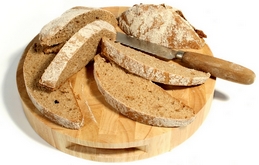02-10-2017, 11:33 AM
31
Re: Soft Spelt Flour...Advice Please..
Originally Posted by Artangel
->
Thanks Omah and Missy for your suggestions! It doesn't taste too bad! I'm sure my hens would like it if l don't eat it!
https://makebreadathome.com/how-to-s...bread-machine/
What to Do if Your Bread Collapses in a Bread Machine
How to Avoid Bread Collapses in a Bread Maker
Doves Farm Roman Army Bread (Oven Version)

https://www.ocado.com/webshop/recipe...my-bread/31594
The extra liquid in this recipe bakes a traditional loaf with a crumpety crumb structure. Olive oil and honey combined with spelt give it a rich, delicious flavour.
Preparation time: 1 hr
Cooking time: 45 mins
02-10-2017, 01:56 PM
32
Re: Soft Spelt Flour...Advice Please..
Originally Posted by Artangel
->
Wait til Realist sees it too!! He will crack up!!
So like I said, spelt is a somewhat erratic grain to handle and even mainstream bakers have difficulty getting consistent results with it.
Don't abandon it though because it has a lovely sweet flavour and is an ancient grain.
It must be understood that certain grains, by themselves, will not make a great everyday loaf. Rye for example has little to no gluten content and so if you tried to make a loaf with just rye flour you would get a very dense heavy brick. On the other hand rye flavour is fantastic and so we use it for all sorts of things. We DO make 100% rye loaves but these are purposely dense cake like affairs like pumpernickle and volkenbort and Borodinsky loaves.
If you want to add great flavour to any everyday loaf just throw about 50g of dark rye flour into the mix. I do that most of the time.
Wholewheat flour has much more gluten but again, doesn't make a great everyday loaf on it's own. That said, a 100% wholemeal loaf even though very dense, is incredibly flavoursome and wholesome and healthy and will keep you filled up for many hours. But it's a thirsty flour and so you need to put more water in a recipe that contains a lot of wholewheat vs one which is mostly white flour.
In the end there is a limit to what you can achieve with a crappy bread making machine. I would strongly encourage you to ditch it and start making your bread by hand which you will find is incredibly easy. No need for any hard strenuous kneading, in fact you only need to do about 40 seconds of "fingertip kneading" in total.
Let's assume though that for now you're going to persist with it.
I'll offer a nice recipe for you which would work if you were making it by hand. With a machine who knows what will happen by try it anyway. The key here is to use spelt as an added flavour rather than for the entire loaf. We need some white flour to provide a strong gluten structure, the backbone if you like, and then we'll throw in some spelt and rye for flavour.
Recipe
for a 500g loaf (scale everything down if your machine is too small for that)
Strong White Bread Flour - 350g
Spelt Flour - 100g
Dark Rye Flour - 50g
Water - 300g
Fresh Baker's Yeast - 5g
Salt - 6g
I make no excuse for listing Baker's yeast. If you want consistently great loaves and not waste ingredients on duff loaves, then you buy baker's yeast simple as. The dry instant yeast is fickle.
You can buy baker's yeast from any Sainsbury's. Just go to the bread counter and ask for 100g of fresh yeast. It will cost about 70p. Keep it in the fridge in a small tupperware pot for many weeks.
If your bread machine will let you make the dough yourself so it just does the bake, then do it that way. If not, mix the yeast with the water before you throw it in the machine.
Mixing By Hand
Weigh all the ingredients carefully inc and esp the water.
Make the water room temperature if possible, just tepid, definitely not hot.
Put the 3 flours in a bowl together with the salt and mix with a spoon or your hands. (use food mixer bowl if you have one).
Put the yeast in a jug, add a tiny bit of the water and stir to incorporate all the yeast, then add the rest of the water.
Now pour the yeasty water into the flours and mix for about 3 to 4 mins if you are using a food mixer, or if you don't have one just use a spatula to mix by hand until everything is well incorporated. Don't be afraid to get your hands in there. Feel the dough. Feel the consistency. Form the dough into a rough ball and then cover the bowl with a large plate and leave for 10 mins.
Put the kettle on and make a cuppa.
After 10 mins, pinch the dough at the outside edge of the ball with your fingers, lift it up (stretch it) and push it down into the middle of the ball.
Rotate the bowl slightly, take another pinch of dough, lift up, push down in the middle. Repeat this until you have been right round the bowl. Should take about 10 seconds to do all that. Cover the bowl again and leave for another 10 mins.
Now repeat this whole process another 3 times, each time leaving the dough to rest 10 mins. So from start to finish you did this:
1. Rest 10 mins, then pinch and folds
2. Rest 10 mins, then pinch and folds
3. Rest 10 mins, then pinch and folds
4. Rest 10 mins, then pinch and folds
So in total you did about 40 seconds of kneading (pinch folds) and that was over a 40 minute period.
This allows the gluten to form and stretch and build. It's no effort at all on your part, no strenuous kneading.
Proofing
Turn the dough over so the smooth side is on top and leave the dough, covered, in a warm place for an hour
It should double in size. If it hasn't withing the hour, just leave it a little longer to proof.
Form The Dough
Once it has doubled in size remove from the bowl onto a lightly floured work surface and form it into a boule or log shape as desired for your machine. Then pop it into your machine. If you're going to be brave and ignore the machine just make a nice tight boule and put it on a baking tray.
Now just leave the dough again for another 20 mins
Test The Dough
Lot's of things affect a dough. The room temperature, the activeness of the yeast, the hydration level etc etc so there is no sure fire recipe that can guarantee a successful loaf. You MUST learn to assess the dough yourself to find out whether it is at the correct point to bake.
There's a simple test for this.
Poke a floured fingertip into the dough gently to make a dimple. Now watch what happens.
If the dimple stays there the dough is already on the way to being over proofed and needs to be baked immediately.
If the dimple immediately springs back then the dough is NOT yet ready and needs to be left longer.
If the dimple slowly springs back then it is perfect and ready to be baked.
Bake
If you're going to use the machine just set it to immediate bake. I don't know how quickly it gets to temperature but in an oven I would bake for 30 mins or so.
If you are using your oven rather than the machine, pre heat the oven to 220 to 240 degrees C. Before you bake the loaf, sprinkle flour on top of the boule and then with a serrated knife (or razor blade) make 3 horizontal cuts about 1 inch deep into the dough and 3 vertical to make a grid pattern. Then pop it into the oven, turn the temp down to 200 degrees and bake for 30 mins.
Hopefully you will get a well sprung loaf with bags of flavour.
This is a spelt loaf I made with slightly different recipe, it had oats and semlina in it as well as the spelt and white flours:
02-10-2017, 02:02 PM
33
Re: Soft Spelt Flour...Advice Please..
And if you find that Spelt Flour is not working with your bread machine then here's a lovely alternative way to use it. It's a good flour to use for baking instead of Plain or Self Raising Flours. Much healthier option too !Spelt Cantuccini with Cranberries, White Chocolate and Candied Peel
My recipe and method are here:
http://www.thefreshloaf.com/node/369...d-candied-peel
14-10-2017, 01:35 PM
34
Re: Soft Spelt Flour...Advice Please..
Realist, l have only just seen your reply. I bet you really laughed at my Spelt bread! Your bread always looks so professional and delicious!Actually, it did taste nice, even though it looked like a baby’s bib when sliced! With hindsight, l think l should have added white flour as well.
I have got some more Spelt flour, so l will have another go soon. I will use the recipe you have posted.
Thank You ever so much for your help.
|
|



